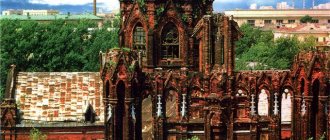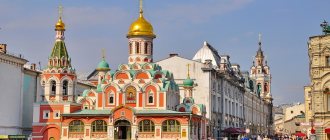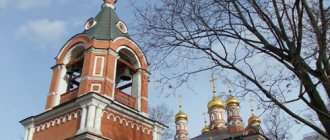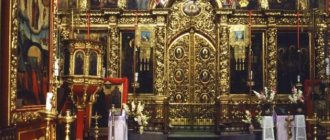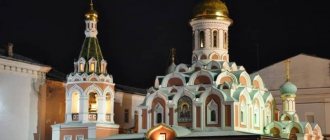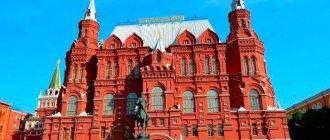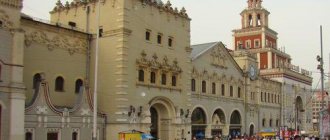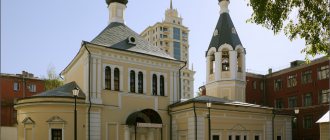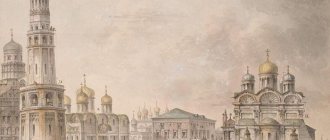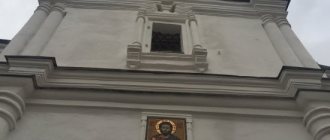Residents of Moscow, as well as its guests, arriving at the main square of the city, Red Square, freeze in admiration when they see St. Basil's Cathedral, unsurpassed in its beauty, next to the Kremlin. This monument of Russian history and culture with its colorful painted domes has long become an integral part of the capital of Russia and its symbol. The official name of this attraction is the Cathedral of the Intercession of the Blessed Virgin Mary on the Moat. Until the 17th century, the cathedral was called Trinity, since the originally built wooden church was dedicated to the Holy Trinity. Currently, the cathedral is included in the list of world cultural heritage and is protected by UNESCO.
ADDITIONAL INFORMATION: ADDRESS. TELEPHONE. HOW TO GET THERE
Address: Moscow Red Square, 7 (metro station Ploshchad Revolyutsii, Teatralnaya, Okhotny Ryad, Kitay-Gorod) Phone (administrator) Official website: shm.ru
Opening hours: September 1 – November 4: 11:00–18:00, daily; November 5 – April 30: 11:00–17:00, daily; May 1 – May 31: 11:00–18:00, daily. The first Wednesday of the month is a sanitary day; June 1 – August 31: 10:00–18:00, daily. The ticket office and area close 45 minutes before. until the museum closes. In summer, the territory of the Intercession Cathedral is open from 9:00 to 19:00, daily. At temperatures below -15, the museum reduces its opening hours. Please check the museum's closing time by phone. During the winter and spring school holidays, the museum's opening hours are extended by 1 hour.
Ticket prices for St. Basil's Cathedral in 2021
- For adult citizens of Russia, Armenia, Belarus, Kazakhstan and Kyrgyzstan - 500 rubles
- For adult citizens of other countries - 1000 rubles
- For children under 7 years old - free (regardless of citizenship)
- For children from 7 to 18 years old in Russia, Armenia, Belarus, Kazakhstan and Kyrgyzstan - 250 rubles
- For children from 7 to 18 years old in other countries - 500 rubles
- For full-time students of the Russian Federation - 250 rubles
- For pensioners - citizens of Russia, Armenia, Belarus, Kazakhstan and Kyrgyzstan on weekdays - 250 rubles
- For pensioners - citizens of Russia, Armenia, Belarus, Kazakhstan and Kyrgyzstan on weekends and holidays - 500 rubles
We strongly recommend taking an audio guide to make your visit more interesting and educational. Audio guide rental cost:
- In Russian - 300 rubles
- In a foreign language - 600 rubles
Photo gallery
St. Basil's Cathedral history
Anyone who enters Red Square immediately notices the bright domes and graceful contours of St. Basil's Cathedral.
Construction of the temple lasted 9 years. The architects were, according to one version, the masters Postnik and Barma, and according to another, an unknown architect. The legend agrees on only one thing - the builders of the temple were blinded by order of Ivan the Terrible.
At first it was a memorial complex of a tented church surrounded by 9 small churches - symbols of major victories over Kazan. The famous figured domes appeared at the end of the 16th century, and a little later a bell tower was built there. During its history, the cathedral suffered from many misfortunes - first, a fire in 1737 destroyed it almost completely, then the cathedral was damaged during the siege of the city by Napoleon's troops. In Soviet times they even wanted to demolish it.
Now the temple is used for worship and as a memorial and historical complex. Its churches house religious relics - the relics of St. John the Wonderworker, ancient icons and religious objects.
The official name of this majestic temple is the Cathedral of the Intercession of the Blessed Virgin Mary on the Moat. But for most tourists around the world it is known as St. Basil's Cathedral, a brief description
which you will find in this article.
He successfully survived the change of eras and ruling elites, numerous wars and revolutions, and even the Soviet fight against religion. Today, St. Basil's Cathedral in Moscow
remains its main attraction, the calling card of the capital.
Cache in the temple.
Another feature of the unique ensemble is the absence of basements. It was erected on a basement - a complex of premises, the height of the walls of which exceeds six meters, and the thickness reaches more than three meters. There are special openings in its walls that serve to create a constant microclimate in the premises, independent of the time of year. In ancient times, the basement was used as a secret storage for church valuables and the royal treasury. The hiding place could only be accessed from the second floor of the central cathedral via a secret staircase located in the wall. Now there is a storage facility for icons that belong to the Church of the Intercession of the Blessed Virgin Mary, which is on the Moat. The oldest of them is the image of St. Basil, dating from the end of the 16th century.
The entire ensemble is surrounded by a covered bypass gallery, which has long become one with it. Like the inner circumference, it is painted with grass and plant patterns dating back to the 17th century. Their floors are lined with bricks, partly with herringbone masonry, and some areas with a special “rosette” pattern. Interestingly, bricks preserved from the sixteenth century are more resistant to abrasion than those used in restoration work.
Description
The Orthodox Church is located on Red Square, next to the monument to Minin and Pozharsky, opposite the Historical Museum. The architectural complex consists of nine churches on one foundation. Reaching 65 meters in height, the cathedral is crowned with 11 bells: nine of them are the domes of the church, one is above the bell tower and another one is above the chapel.
Churches are symbols of religious holidays during the capture of the Kazan Khanate. This decision was not made by chance, since St. Basil's Cathedral was built in honor
this significant event in the history of the country, by order of Tsar Ivan the Terrible.
All domes are made in bright colors, none of them is the same in texture or color design. The churches are connected by arched passages and galleries.
Although the official name of the temple is the Cathedral of the Intercession of the Blessed Virgin Mary, throughout the world it is known primarily as St. Basil's Cathedral. Holy fools were called blessed, and they were treated with due respect in Moscow. Vasily was the most famous holy fool of the city and was distinguished by deep piety and the gift of prediction, which is why his name gave the cathedral another name, more widely known.
Cathedral of the Intercession of the Blessed Virgin Mary
Before my next trip to the capital during the New Year holidays 2019, I knew little about St. Basil’s Cathedral, which is a unique architectural structure that we passed by more than once during previous visits. Perhaps the only thing is that the Intercession Cathedral is not just a church, but a temple-monument, erected in honor of the annexation of the Kazan Khanate to the Russian state at the behest of Tsar Ivan the Terrible, who vowed to build a church in memory of this event in the event of the successful capture of Kazan.
The cathedral, now included in the list of UNESCO cultural heritage sites, is jointly managed by the Historical Museum of Moscow and the Russian Orthodox Church. On Sundays, services are held there. You can get to the museum six days a week (except Mondays) according to the museum’s opening hours.
The cathedral is located at the address: Moscow, Red Square, 7
Open daily from 11:00 to 18:00
Official website: https://shm.ru/museum/hvb/
Ticket prices can be viewed here: https://shm.ru/visit/tickets/hvb/
Having the intention of looking at the Cathedral during this trip, I studied the information about it in detail. I’ll tell you about the most interesting facts and mysteries in my review.
It turns out that initially on the site of the cathedral there was a wooden Trinity Church, around which, during the campaigns against Kazan, churches were erected to celebrate the great victories of the Russian army. When Kazan finally fell, Metropolitan Macarius proposed to Ivan the Terrible to rebuild the architectural ensemble in stone, wanting to surround the central temple with seven churches, but for the sake of symmetry the number was increased to eight. So, on one foundation, nine independent churches and a belfry were built, connected by vaulted passages. Outside, the churches were surrounded by an open gallery called the walkway, which was a kind of church porch. Each temple was crowned with its own dome with a unique design and original drum decoration. The 65-meter-high structure, grandiose at the time, was built in just six years, from 1555 to 1561. Until 1600, St. Basil's Cathedral was the tallest building in Moscow.
The main battle for Kazan, in which Russian troops were victorious, took place on the day of the Intercession of the Most Holy Theotokos, so the temple was consecrated in honor of this Christian holiday. The official name of the temple is the Cathedral of the Intercession on the Moat, but the generally accepted name is St. Basil's Cathedral.
Saint Basil the Blessed lived in Moscow in the 16th century. He was a holy fool, a religious ascetic who rejected worldly goods. Life says that all year round Vasily walked the streets of Moscow barefoot, almost without clothes, slept on the street, observed strict fasting, and also preached mercy and help to his neighbors. There were also legends about his prophetic gift: they say he predicted the Moscow fire of 1547.
According to legend, St. Basil the Blessed collected money for the construction of the Intercession Cathedral. When he died, he was buried at the Trinity Church, and later his relics were moved to the Intercession Cathedral. The saint was greatly revered, and his memory has been preserved to this day.
St. Basil's Cathedral inside
The general view of the Intercession Cathedral is so famous that not all tourists know that there are museum exhibitions inside and excursions are held. To better understand the meaning and history of St. Basil's Cathedral on Red Square,
should go inside.
The first thing that fascinates a tourist is the picturesque passage galleries between churches, reminiscent of colorful images from Russian folk tales. The walls and domes are painted with the faces of saints and images from their lives. The temple has many ancient icons and frescoes made in the 16th and 17th centuries. The paintings were updated several times in the mid and late 19th century.
Inside St. Basil's Cathedral
You can take
photos
with the flash turned off.
Today, the Cathedral houses a branch of the State Historical Museum, where, in addition to icons and church utensils, you can see samples of ancient weapons and bells cast several centuries ago.
July guest
Plus 12,500 new subscribers on social networks and 500 thousand virtual visitors, with these results the museum ends the online period of its existence during the pandemic.
But opening the doors of the museum on July 1 and welcoming the first visitors with the music of a live orchestra (“We really missed the audience,” admits Levykin), the museum has not yet set itself the goal of reaching the pre-quarantine number of visits. The main thing for him is to recover and ensure the safety of his visitors. The modes of visiting the museum so far suggest excursion groups of no more than 5 people, visits to the main building will be divided into 15-minute sessions, St. Basil's Cathedral - into 10-minute sessions, and the chambers of the Romanov boyars - into 20-minute sessions (however, after entering, you will remain in the museums of the State Historical Museum it can be as long as you like). At the same time, the main building and the museum of 1812 will be open from 10 to 21 hours, St. Basil's Cathedral and the Chamber of the Romanov Boyars - from 10 to 19. The State Historical Museum will be open seven days a week. Online ticket sales will be given priority. Social distancing, masks, gloves (which can also be purchased at the museum kiosk), all precautions will remain in force until August 1.
The unique exhibits of the Historical Museum miss the “living view”
Alexey Levykin invited visitors to the Fabergé exhibition, which is breaking all records of popularity, which will last until the fall, and drew attention to the exhibition, which has become especially relevant during quarantine, prepared for the 75th anniversary of the Victory and dedicated to the feat of medical services during the Great Patriotic War. Admission to the exhibition (and therefore to the museum) for doctors is free.
The museum plans to open the Rokotov exhibition at the end of July, but other exhibition plans, according to Levykin, may have to be curtailed, postponing them to 2021. The museum will keep some of its online events (and there have been 1,000 of them during quarantine) so why curtail, for example, the very popular short online lectures dedicated to one particular museum subject? Moreover, the increase in visits (and especially 250 thousand virtual visits to the State Historical Museum on the famous “Night of Museums,” also held online this year) indicates a growing interest in history and culture among the younger generation.
The State Historical Museum is going to continue work on creating a branch in Tula and is proud of a new publication dedicated to the “Golden Pantry” of the museum, which appeared just during quarantine. Levykin recalled that fundraising for the restoration of the monument to Minin and Pozharsky continues, and the restoration itself will begin this year. Answering a question from journalists whether Chinese tourists, for example, are welcome at the State Historical Museum, Alexey Levykin emphasized: “Of course, like other foreign guests.” But he added that the percentage of foreign visitors to the museum reached 4 and only after the World Cup reached 25. The main viewer of the museum is Russian. As a specialist in Russian and foreign antique weapons, he reminded the July audience about the weapons masterpieces of the State Historical Museum - a royal collection of armor from the 16th-17th centuries, a wonderful collection of firearms and the unique saber of Alexander II, which was with him during the assassination attempt. I immediately wanted to touch this weapon with my “live eyes.”
How the temple was created
Construction of the cathedral began in 1555 and lasted until 1561. During restoration work in the 20th century, the exact date for the opening of the cathedral was established - July 12, 1561, the day of Saints Peter and Paul.
It is not known for certain who built St. Basil's Cathedral
. There are several versions in which historical facts are firmly intertwined with legends.
According to the first of them, the construction was supervised by the architect Postnik Yakovlev from Pskov and the master Ivan Barma (many argue that it was the same person). According to city legends, upon completion of construction they were blinded in order to deprive the craftsmen of the opportunity to repeat such a masterpiece.
However, historians have already proven that this version is nothing more than a legend, since it is precisely established that Postnik later took part in the construction of the Kremlin in Kazan. There is also a version that the cathedral was built without a single drawing, and a diagram drawn right on the construction site served as a guide.
According to the second version, another architect took part in the construction of the temple, whose name remains unknown. Presumably, he was from Italy, so characteristic elements of the European Renaissance are noticeable in the architectural style of the temple. But no official documents confirming this version have survived either.
Cathedral in different years
St. Basil's Cathedral was rebuilt and restored several times. This was due to frequent fires on Red Square, where wooden houses were mainly built. Over time, the wooden canopies were replaced with roofing, vaulted tents were built over the white stone stairs, and a two-level bell tower with an open area for bell ringers was erected.
In the 19th century, significant changes took place in the interior decoration of the cathedral. On the walls, oil paintings depicted the faces of saints and scenes from their lives. The walls were decorated with a pattern reminiscent of large stone masonry.
During the Patriotic War of 1812, the troops of Napoleon Bonaparte kept their horses in the basement of the Intercession Church. The emperor himself admired the beauty of the cathedral so much that he even planned to move it to France. Convinced that this was impossible, the French plundered and destroyed the cathedral, which was rebuilt at the end of hostilities.
